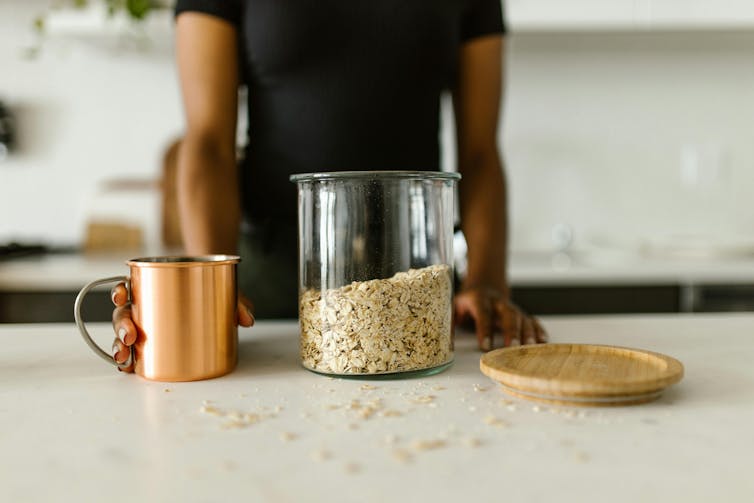Food prices are , especially for Australians on the lowest incomes.
Author
Clare Collins
Laureate Professor in Nutrition and Dietetics, University of Newcastle
To help save money on the weekly groceries, consider adding these five staples to your shopping trolley: eggs, oats, carrots, UHT milk and apples. These foods rate highly on the and on cost, meaning they represent good value for money when it comes to buying nutritious food.
Loading up on these items helps push more expensive, less nutritious foods out of your trolley. Keeping a supply at your place will also save extra trips to the shops, which saves petrol and time.
1. Eggs
Eggs are extremely good value at around A$6 a dozen (50 cents an egg).
Meat, chicken and fish prices vary from $12 a kilo for mince, $12-$20 a kilo for chicken, to $20-$50 a kilo for steak and fish depending on cut or type. Selecting the cheapest cuts still costs $2-$3 a serve, compared to two eggs at a $1 serve.
When you swap a red meat meal for an eggy dish, this can add up to a big saving. Try our egg recipes on the , from , to , or . These recipes also help use up other items you have in the pantry, fridge and veggie crisper.
Eggs are a good of protein and also contain choline, lutein and zeaxanthin, vitamins A, B2, B12, D, E and folate, and minerals iron, zinc, iodine and selenium.
For people concerned about eggs raising cholesterol, a concluded there wasn’t likely to be any adverse effect on overall disease risk when consuming up to one egg a day.
2. Rolled oats
Rolled oats vary a lot in price from about $2 a kilogram for “own brand”, up to $9 for premium varieties.
Oats are really . For breakfast you can make , DIY muesli or .
Oats make a pastry substitute for a . Or blitz them in a food processor and use as a breadcrumb substitute.
For dessert, you can use them to top a comforting .

, meaning they retain every part of the original grain – the germ, bran and outer layers – and hence more fibre and nutrients.
Oats are a rich in beta-glucan, a soluble fibre that by binding with bile acids in the gut, meaning they can’t be converted into LDL (bad) cholesterol.
They B vitamins of thiamin (b1), riboflavin (B2), niacin (B3), pyridoxine (B6), pantothenic acid (B5) and folate (B9), as well as vitamin E and the minerals iron, zinc, magnesium, phosphorus and potassium.
3. Carrots
It’s hard to get better value than a bag of carrots at about $2.50 a kilo. They last for ages in the fridge and can be eaten raw, as carrot sticks or with , or baked to make carrot veggie ““.
Try grating carrot as an extra on a salad roll or , or mixed into grated cheese to extend it when topping tacos, pasta or pizza, or even a dish like .
Other versatile uses include soup, , or, for something sweet, carrot muffins or .
Carrots are rich in the carotenoids , which get converted into vitamin A in the body and used in antibody production and to maintain of your eyes, skin, lungs and gut.
4. Longlife skim milk
Longlife skim milk costs about $1.60 a litre.

While some fresh varieties are around the same price, the value of longlife milk is that you can keep a store of it in the cupboard, meaning you never run out and it has a long shelf life.
Milk makes great and is an essential ingredient in dishes from quiche to to pudding.
protein, calcium, magnesium, zinc, potassium and vitamins A, B2 and B12.
Research shows regular milk consumption is a lower risk of developing osteoporosis, high blood pressure, type 2 diabetes, heart disease and colon cancer.
5. Apples
A bag of apples costs about $4 or 60 cents an apple and $4-$5 for a large can of stewed apple.
Apples make a portable snack. Add , serve , or in .
Apples dietary fibre and pectin, vitamin B6 and C, and the minerals potassium, calcium, nitrogen, magnesium and traces of zinc, iron and copper.
In , people who ate more apples had a lower risk of heart disease, stroke, type 2 diabetes and death from any cause.
For easy, tasty, economical meals that are quick to prepare, without too much effort, along with our food budget tips, visit our team’s website.
![]()
Clare Collins AO is a Laureate Professor in Nutrition and Dietetics at the University of Newcastle, NSW and a Hunter Medical Research Institute (HMRI) affiliated researcher. She is a ³Ô¹ÏÍøÕ¾ Health and Medical Research Council (NHMRC) Leadership Fellow and has received research grants from NHMRC, ARC, MRFF, HMRI, Diabetes Australia, Heart Foundation, Bill and Melinda Gates Foundation, nib foundation, Rijk Zwaan Australia, WA Dept. Health, Meat and Livestock Australia, and Greater Charitable Foundation. She has consulted to SHINE Australia, Novo Nordisk, Quality Bakers, the Sax Institute, Dietitians Australia and the ABC. She was a team member conducting systematic reviews to inform the 2013 Australian Dietary Guidelines update, the Heart Foundation evidence reviews on meat and dietary patterns and current Co-Chair of the Guidelines Development Advisory Committee for Clinical Practice Guidelines for Treatment of Obesity.








